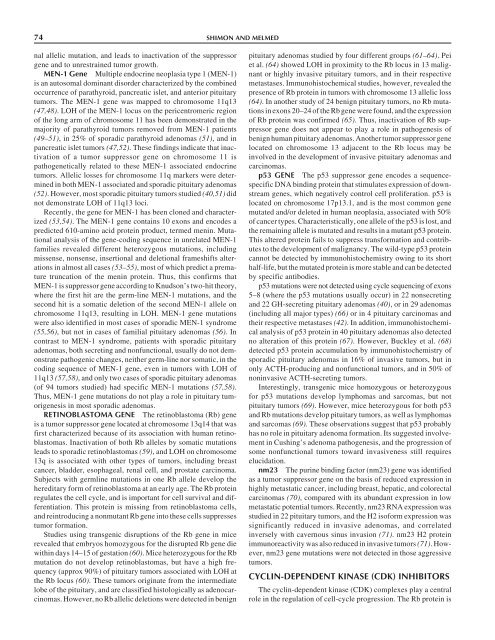Diagnosis and Management of Pituitary Tumors
Diagnosis and Management of Pituitary Tumors
Diagnosis and Management of Pituitary Tumors
You also want an ePaper? Increase the reach of your titles
YUMPU automatically turns print PDFs into web optimized ePapers that Google loves.
74 SHIMON AND MELMEDnal allelic mutation, <strong>and</strong> leads to inactivation <strong>of</strong> the suppressorgene <strong>and</strong> to unrestrained tumor growth.MEN-1 Gene Multiple endocrine neoplasia type 1 (MEN-1)is an autosomal dominant disorder characterized by the combinedoccurrence <strong>of</strong> parathyroid, pancreatic islet, <strong>and</strong> anterior pituitarytumors. The MEN-1 gene was mapped to chromosome 11q13(47,48). LOH <strong>of</strong> the MEN-1 locus on the pericentromeric region<strong>of</strong> the long arm <strong>of</strong> chromosome 11 has been demonstrated in themajority <strong>of</strong> parathyroid tumors removed from MEN-1 patients(49–51), in 25% <strong>of</strong> sporadic parathyroid adenomas (51), <strong>and</strong> inpancreatic islet tumors (47,52). These findings indicate that inactivation<strong>of</strong> a tumor suppressor gene on chromosome 11 ispathogenetically related to these MEN-1 associated endocrinetumors. Allelic losses for chromosome 11q markers were determinedin both MEN-1 associated <strong>and</strong> sporadic pituitary adenomas(52). However, most sporadic pituitary tumors studied (40,51) didnot demonstrate LOH <strong>of</strong> 11q13 loci.Recently, the gene for MEN-1 has been cloned <strong>and</strong> characterized(53,54). The MEN-1 gene contains 10 exons <strong>and</strong> encodes apredicted 610-amino acid protein product, termed menin. Mutationalanalysis <strong>of</strong> the gene-coding sequence in unrelated MEN-1families revealed different heterozygous mutations, includingmissense, nonsense, insertional <strong>and</strong> deletional frameshifts alterationsin almost all cases (53–55), most <strong>of</strong> which predict a prematuretruncation <strong>of</strong> the menin protein. Thus, this confirms thatMEN-1 is suppressor gene according to Knudson’s two-hit theory,where the first hit are the germ-line MEN-1 mutations, <strong>and</strong> thesecond hit is a somatic deletion <strong>of</strong> the second MEN-1 allele onchromosome 11q13, resulting in LOH. MEN-1 gene mutationswere also identified in most cases <strong>of</strong> sporadic MEN-1 syndrome(55,56), but not in cases <strong>of</strong> familial pituitary adenomas (56). Incontrast to MEN-1 syndrome, patients with sporadic pituitaryadenomas, both secreting <strong>and</strong> nonfunctional, usually do not demonstratepathogenic changes, neither germ-line nor somatic, in thecoding sequence <strong>of</strong> MEN-1 gene, even in tumors with LOH <strong>of</strong>11q13 (57,58), <strong>and</strong> only two cases <strong>of</strong> sporadic pituitary adenomas(<strong>of</strong> 94 tumors studied) had specific MEN-1 mutations (57,58).Thus, MEN-1 gene mutations do not play a role in pituitary tumorigenesisin most sporadic adenomas.RETINOBLASTOMA GENE The retinoblastoma (Rb) geneis a tumor suppressor gene located at chromosome 13q14 that wasfirst characterized because <strong>of</strong> its association with human retinoblastomas.Inactivation <strong>of</strong> both Rb alleles by somatic mutationsleads to sporadic retinoblastomas (59), <strong>and</strong> LOH on chromosome13q is associated with other types <strong>of</strong> tumors, including breastcancer, bladder, esophageal, renal cell, <strong>and</strong> prostate carcinoma.Subjects with germline mutations in one Rb allele develop thehereditary form <strong>of</strong> retinoblastoma at an early age. The Rb proteinregulates the cell cycle, <strong>and</strong> is important for cell survival <strong>and</strong> differentiation.This protein is missing from retinoblastoma cells,<strong>and</strong> reintroducing a nonmutant Rb gene into these cells suppressestumor formation.Studies using transgenic disruptions <strong>of</strong> the Rb gene in micerevealed that embryos homozygous for the disrupted Rb gene diewithin days 14–15 <strong>of</strong> gestation (60). Mice heterozygous for the Rbmutation do not develop retinoblastomas, but have a high frequency(approx 90%) <strong>of</strong> pituitary tumors associated with LOH atthe Rb locus (60). These tumors originate from the intermediatelobe <strong>of</strong> the pituitary, <strong>and</strong> are classified histologically as adenocarcinomas.However, no Rb allelic deletions were detected in benignpituitary adenomas studied by four different groups (61–64). Peiet al. (64) showed LOH in proximity to the Rb locus in 13 malignantor highly invasive pituitary tumors, <strong>and</strong> in their respectivemetastases. Immunohistochemical studies, however, revealed thepresence <strong>of</strong> Rb protein in tumors with chromosome 13 allelic loss(64). In another study <strong>of</strong> 24 benign pituitary tumors, no Rb mutationsin exons 20–24 <strong>of</strong> the Rb gene were found, <strong>and</strong> the expression<strong>of</strong> Rb protein was confirmed (65). Thus, inactivation <strong>of</strong> Rb suppressorgene does not appear to play a role in pathogenesis <strong>of</strong>benign human pituitary adenomas. Another tumor suppressor genelocated on chromosome 13 adjacent to the Rb locus may beinvolved in the development <strong>of</strong> invasive pituitary adenomas <strong>and</strong>carcinomas.p53 GENE The p53 suppressor gene encodes a sequencespecificDNA binding protein that stimulates expression <strong>of</strong> downstreamgenes, which negatively control cell proliferation. p53 islocated on chromosome 17p13.1, <strong>and</strong> is the most common genemutated <strong>and</strong>/or deleted in human neoplasia, associated with 50%<strong>of</strong> cancer types. Characteristically, one allele <strong>of</strong> the p53 is lost, <strong>and</strong>the remaining allele is mutated <strong>and</strong> results in a mutant p53 protein.This altered protein fails to suppress transformation <strong>and</strong> contributesto the development <strong>of</strong> malignancy. The wild-type p53 proteincannot be detected by immunohistochemistry owing to its shorthalf-life, but the mutated protein is more stable <strong>and</strong> can be detectedby specific antibodies.p53 mutations were not detected using cycle sequencing <strong>of</strong> exons5–8 (where the p53 mutations usually occur) in 22 nonsecreting<strong>and</strong> 22 GH-secreting pituitary adenomas (40), or in 29 adenomas(including all major types) (66) or in 4 pituitary carcinomas <strong>and</strong>their respective metastases (42). In addition, immunohistochemicalanalysis <strong>of</strong> p53 protein in 40 pituitary adenomas also detectedno alteration <strong>of</strong> this protein (67). However, Buckley et al. (68)detected p53 protein accumulation by immunohistochemistry <strong>of</strong>sporadic pituitary adenomas in 16% <strong>of</strong> invasive tumors, but inonly ACTH-producing <strong>and</strong> nonfunctional tumors, <strong>and</strong> in 50% <strong>of</strong>noninvasive ACTH-secreting tumors.Interestingly, transgenic mice homozygous or heterozygousfor p53 mutations develop lymphomas <strong>and</strong> sarcomas, but notpituitary tumors (69). However, mice heterozygous for both p53<strong>and</strong> Rb mutations develop pituitary tumors, as well as lymphomas<strong>and</strong> sarcomas (69). These observations suggest that p53 probablyhas no role in pituitary adenoma formation. Its suggested involvementin Cushing’s adenoma pathogenesis, <strong>and</strong> the progression <strong>of</strong>some nonfunctional tumors toward invasiveness still requireselucidation.nm23 The purine binding factor (nm23) gene was identifiedas a tumor suppressor gene on the basis <strong>of</strong> reduced expression inhighly metastatic cancer, including breast, hepatic, <strong>and</strong> colorectalcarcinomas (70), compared with its abundant expression in lowmetastatic potential tumors. Recently, nm23 RNA expression wasstudied in 22 pituitary tumors, <strong>and</strong> the H2 is<strong>of</strong>orm expression wassignificantly reduced in invasive adenomas, <strong>and</strong> correlatedinversely with cavernous sinus invasion (71). nm23 H2 proteinimmunoreactivity was also reduced in invasive tumors (71). However,nm23 gene mutations were not detected in those aggressivetumors.CYCLIN-DEPENDENT KINASE (CDK) INHIBITORSThe cyclin-dependent kinase (CDK) complexes play a centralrole in the regulation <strong>of</strong> cell-cycle progression. The Rb protein is















